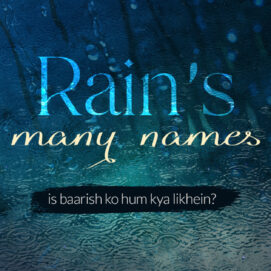अधिक खोजे गए शब्द
सहेजे गए शब्द
खिस्यानी बिल्ली खम्बा नोचे
जिसे क्रोध आ रहा हो वह अपनी खीझ या क्रोध दूसरों पर उतारता है, लाचारी में आदमी दूसरों पर क्रोध करता है, लज्जित व्यक्ति दूसरों पर अपनी लज्जा उतारता है, निर्बल की खीझ
कोशिश
कोई काम करने के लिए विशेष रूप से किया जानेवाला प्रयत्न, मेहनत, दौड़ धूप, प्रयत्न, प्रयास, चेष्टा, उद्योग, श्रम, उद्यम, उपाय, परिश्रम
आठ बार नौ त्योहार
सुख-सुविधा और आराम का शौक़ या लगन ऐसा बढ़ा हुआ है कि युग और समय उसको अल्प व्यय नहीं करने देता
चमनिस्तान
ऐसा बाग़ जहाँ फूल ही फूल हों, ऐसी जगह जहाँ दूर तक फूल ही फूल और हरा भरा नज़र आए, वाटिका, चमन, बाग़
दादरा
संगीत में एक प्रकार का चलता गाना (पक्के या शास्त्रीय गानों से भिन्न), एक प्रकार का गान, एक ताल
Jahaan-e-Rang: Mastering the ‘Colors’ in Urdu

In the rich tapestry of the Urdu language, color names are woven with elegance and history, evoking vivid imagery and cultural depth. Each hue carries a poetic resonance, from the gentle whisper of "shang-rafii" to the vibrant embrace of "kaasni." As modernity often leads us away from these exquisite expressions, we embark on a journey to revive and celebrate the forgotten splendor of Urdu's chromatic lexicon. This article is a tribute to the timeless beauty of these words, aiming to preserve our shared linguistic heritage and inspire a renewed appreciation for the language’s profound artistry.
Are you someone who is passionately obsessed with advanced Urdu words and phrases? If so, this write-up will be a delightful addition to your linguistic repertoire as we will explore the names of colors in Urdu.
Sha.ngarafii (شَنْگْرَفی): The first color we'll discuss is sha.ngarafii or Shanj-rafii. According to the Oxford Urdu-English Dictionary, this term denotes light pink or pale red. Another English equivalent for ha.ngarafii could be vermillion, a deep, rich shade of red. The name sha.njarafii is derived from Shanjraf (شنجرف), a red mercuric sulfide used primarily as a pigment in paints, rubber, and plastics.
Malaagiirii (مَلاگیِری): Next is Malaagiirii, which represents the sandalwood color. It is also known as Jogiya (جوگیا) and Geruaa (گیروا), with slight variations in shade. The term Malaagiirii originates from Malaagiir, referring to a sandal-like wood that when crushed and mixed with red color, is used to dye clothes. This color is beautifully captured in the following couplet by Rind Lucknavi:
agarī kā hai gumāñ shak hai malāgīrī kā
rañg laayā hai dupaTTa tirā mailā ho kar
Kabuudii (کبودی): Exploring more exquisite Urdu colors, the third one on our list is Kabuudii, a Persian word translated to English as Sapphire Blue. This color is also known as azure or sky-blue. In Urdu, it has other names such as Aasmaani Niilaa (آسمانی نیلا) and Niilguun (نیلگوں). The beauty of Kabuudii is elegantly captured in the following lines:
zor yaaro aaj ham ne fat.h kī jañg-e-falak
yak tamāñche meñ kabūdī kar diyā rañg-e-falak
Shuturii (شتری): Another natural color is Shutrii, derived from the Persian word Shutr (شتر), meaning camel. Thus, Shutrii translates to "the color of the camel." In Urdu, it is also referred to as Baadaamii (بادامی) and Halkaa Bhuuraa (ہلکا بھورا).
Zumurrudii (زمردی): Zumurrud (زمرد), or emerald, is one of the most precious gemstones, characterized by its bright and vivid shade of green. In Urdu, the emerald green is called Zumurrudii, derived from Zumurrud. This color is poetically described in the following lines by Fakhir Lakhnavi:
ham mar ga.e haiñ ishq meñ ik sabz rang ke
gumbad zamurrudī ho hamārī mazār kā
Qirmizii (قرمزی): One of the gentlest color names in Urdu is Qirmizii, meaning Scarlet or Crimson. Originally a Persian term, it is also known as Gahraa-Surkh (گہرا سرخ) in spoken Urdu. Qirmizii denotes a rich, deep-red, or bright-red color with a slight orange tinge.
qirmizī sā āftāb aur dhundlā joban
āsmāñ par duur tak the āsmānī rang
Kaahii (کاہی): The next color is Kaahii, which means grass-green or straw-colored. Sometimes referred to as grassy or dark green, the word Kaahii is of Persian origin, derived from Kaah (کاہ), meaning straw, hay, or chaff. Mirza Azfari beautifully uses Kaahii to describe the grass-green color in the following couplet:
dhānī joḌe pe tire sāñvle maiñ martā huuñ
mar bhī jā.ūñ to kafan dekh ke kaahī denā
Kaakrezii (کاکریزی): Continuing Our Journey through the colors of Urdu, next, we have Kaakrezii, a Persian-origin word for Dark Purple. In colloquial Urdu, it is sometimes referred to as syaahii-maa’el uudaa (سیاہی مائل اودا) or gahraa uudaa rang (گہرا اودا رنگ).
Agarii (اَگْرئی): The second last color in our discussion is agarii, which denotes the color of aloe wood or brown. This term is derived from Agar, meaning aloe wood that gives off fragrance when burned. In Urdu, Agarii can also be described as gahraa kishmishi rang (گہرا کشمشی رنگ), zardii-ma’el (زردی مائل), or bhuuraa rang (بھورا رنگ).
Kaasni (کاسنی): The final color we explore today is Kaasni, which means Lilac. This Persian-origin word refers to a light purple color. In Urdu, it is expressed as surkhii ma’il niilaa (سرخی مائل نیلا), halkaa uudaa (ہلکا اودا), or sometimes sausanii rang (سوسنی رنگ). This color is beautifully captured in Ada Jafarey's couplet defining the nature of night:
añdherī kāsnī rāteñ yahīñ se ho ke guzreñgī
jalā rakhnā koī dāġh-e-jigar āsāñ nahīñ hotā
Another exquisite couplet by Bimal Krishn Ashk further elaborates on Kaasni:
jī chāhtā hai aaj alganī ye dekhiye
saarī vahī saped vahī kāsnī qamīs
As we delve into the vibrant and sophisticated world of Urdu's color terminology, we've uncovered a stunning array of hues, from "shang-rafii" (light pink) to "kaasni" (lilac). Each color name carries its own story and linguistic heritage, reflecting the deep cultural roots of the Urdu language. Preserving and using these words enriches our language and strengthens our connection to our history and identity. Let us cherish and celebrate the beauty and diversity of our linguistic heritage, ensuring that these exquisite colors continue to illuminate our lives.
kabhī surma.ī kabhī ātishī kabhī nuqra.ī kabhī kāsnī
kisī ek rañg meñ rah ke jī hī lagānā ho kahīñ yuuñ na ho
Delete 44 saved words?
क्या आप वास्तव में इन प्रविष्टियों को हटा रहे हैं? इन्हें पुन: पूर्ववत् करना संभव नहीं होगा





